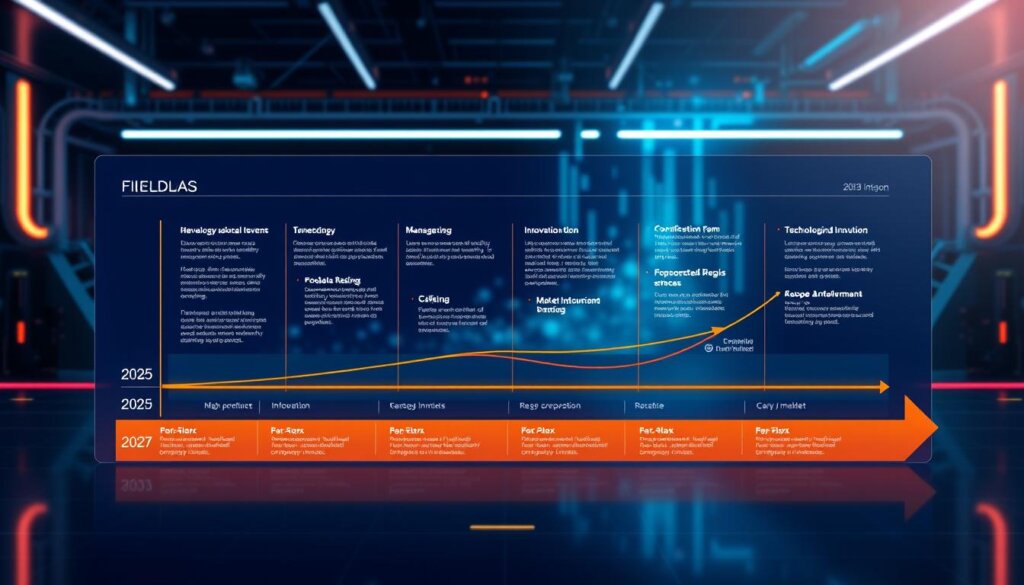I remember the first time I watched a small marketing team turn raw metrics into fast, clear decisions. They used new tools and shifted behavior overnight. That moment showed me how intelligence and analytics can move companies from guesswork to measurable growth.
In this report I set the lens on FieldAx and its rivals across the market. I rely on concrete data—adoption rates, revenue lift, and time-to-insight—to separate marketing claims from real impact. The global AI market context and how teams adopt tools shape the way I judge performance.
My aim is simple: give practical, transparent insights so leaders can weigh costs, innovation, and customer outcomes. I track metrics like revenue lift, cost reduction, and decision quality so you can see where FieldAx delivers real value in your industry.

Key Takeaways
- Context matters: adoption and industry shape outcomes.
- I measure time-to-insight, revenue lift, and cost reduction for real clarity.
- Companies that use AI for decisions often report higher growth and lower costs.
- User experience and tool integration drive operational value first.
- I prioritize transparency in methods so you can trust the report.
How I Structured This Trend Analysis and What “Data-Driven” Means in 2025
I designed this study to translate telemetry and outcomes into clear, repeatable guidance for organizations and teams. My aim was to make metrics practical so leaders can move from noise to verified insights.
Evaluation criteria
I score products on four clear dimensions: accuracy, speed, transparency, and business impact. Each maps to specific analytics tests and decision checkpoints that show how tools perform in real use.
Sources and signals
I rely on broad and deep data sources: usage telemetry, implementation timelines, and outcome reporting. Concrete indicators include near 75% AI adoption, 40% use of AI for decision tasks, about 10% revenue lift, and 15% cost reduction.
Scope and methods
The scope covers roles from analysts to ops and industries with differing risk profiles. I detail data collection practices, separate correlation from causation, and include pricing context (roughly $20/month tiers and open APIs) so businesses can judge access and use.
The Decision-Intelligence Landscape Today: Why This Comparison Matters
Companies now live in an environment where constant streams of information force quicker, higher-stakes choices. I wrote this section to show why evaluating tools matters for real teams and real outcomes.
Present-day context: exploding data, real-time needs, and AI maturity
We operate in a mixed landscape where legacy analytics and newer intelligence coexist. That mix exists because the need for speed and accuracy has outpaced many historical processes.
Real-time event streams, rising machine learning maturity, and varied platform readiness change how teams work. Marketing, product, and operations feel this in forecasting and next-best-action work.
Key stats I used: adoption, decision use, and the holdouts
I focus on headline figures: 75% of businesses have adopted AI in some capacity and 40% use it for core decisions. Still, about 60% rely on traditional methods for many workflows.
Adoption varies by industry: finance and retail lead, while healthcare and manufacturing move more cautiously. Firms using AI-driven decisioning report roughly a 10% revenue lift and 15% cost reduction, and they are 20–30% likelier to hit strong growth.
These facts shape my evaluation so the report ties tool behavior to measurable outcomes and repeatable processes, not just feature lists.
Where FieldAx Competes: Category, Competitor Set, and Market Positioning
My analysis places FieldAx in the market where analytics meet actionable intelligence. I view this as a zone where machine learning must turn raw data into timely insights that teams can act on. That focus shapes how I compare vendors and judge fit for real businesses and industries.
Defining the category
I define FieldAx’s category at the intersection of analytics, machine learning, and decision intelligence. The right platform converts data into clear recommendations and shortens time-to-action.
Competitor archetypes and ecosystem fit
Traditional analytics suites evolved from BI and reporting. AI-native platforms build continuous intelligence from day one. Microsoft-first stacks often favor GPT-4o integrations and Power BI workflows, while Google-first setups lean on Gemini 1.5 Pro and Sheets.
Positioning and signals I track
FieldAx aims to stand out on explainability, governance, and deep integrations. I track feature velocity, implementation speed, and sustained usage as leading market signals. My final judgment focuses on revenue lift and time-to-insight, not just marketing claims.
A Data-Driven 2025 Comparison: Methodology, Weightings, and Scoring
I built a clear approach that turns measurable signals into a repeatable score. The model anchors on revenue impact, cost-to-serve, and time-to-insight so leaders see real business value.
Signals of value
I weigh observable gains—near 10% revenue and 15% cost reduction—alongside adoption rates to set benchmarks. I use data and user insights to mark whether a tool delivers those outcomes in practice.
Weighting for current realities
Explainability, governance readiness, and continuous intelligence get extra weight because they drive trust and repeatable decisions. That helps management pick tools that scale safely.
Evidence hierarchy and scoring
Documented results linked to processes score highest. Live demos rank next, and unverified claims score lowest. I blend quantitative metrics with qualitative user feedback to avoid single-metric bias.
Finally, the framework normalizes for regulated markets and includes scenario tests: speed on real datasets, clarity of model behavior, and ease of management. This makes the study and final report practical for business teams and future planning.
Data Foundations: Sources, Collection, Quality, and Governance Readiness
I start by testing how platforms handle the messy reality of multiple input types and changing schemas. Modern systems must accept structured tables, documents, images, and voice while keeping pipelines stable. Reliable data sources are the base for fast, repeatable insights.

Multi-source readiness
I evaluate FieldAx’s ability to unify diverse inputs so organizations can extract insights without brittle pipelines. I check ingestion, validation, and automated quality checks to cut manual work and speed up processes.
Integrity, lineage, and privacy
I examine lineage tracking and bias mitigation to ensure audits and trust at scale. I also review privacy-by-design features and how management enforces policies across teams and industries.
Finally, I score strategy alignment and growth capabilities. That includes repeatable ingestion patterns, templates, and governance guardrails that reduce implementation risk and help companies meet market expectations for dependable insights.
Machine Learning and Predictive Analytics: From Models to Outcomes
I test how models translate raw signals into clear actions that teams can trust. My focus is on whether FieldAx turns machine outputs into repeatable business results, not just dashboard charts.
Supervised, unsupervised, and reinforcement learning in practice
I examine how FieldAx supports supervised models for forecasting and classification, unsupervised methods for clustering and anomaly detection, and reinforcement learning for sequential choices like pricing or allocation.
Supervised learning powers reliable forecasts. Unsupervised learning surfaces hidden segments. Reinforcement methods optimize policies over time.
Accuracy, drift handling, and automated retraining
I test predictive accuracy with rolling windows and holdout periods while tracking drift. I note whether the platform flags performance drops and triggers automated retraining or alerts for human review.
Business outcomes and pipeline robustness
My benchmarks look for outcomes near 10% revenue growth and 15% cost savings where evidence exists. I also evaluate end-to-end pipelines: feature engineering, deployment, versioning, and approvals.
I check if marketing and operations can turn predictions into action via uplift tests and next-best-offer flows. Finally, I measure whether these ML capabilities move KPIs, not just model metrics, and scale across multiple use cases without bottlenecks.
Real-Time to Continuous Intelligence: Closing the Decision Loop
I watch systems move from passive dashboards to continuous pipelines that act when events matter most.
Event streaming and alerting must do more than notify teams. I evaluate FieldAx’s stack to see if event streams trigger policies that move insights into immediate actions. That includes latency checks and reliability tests under real load.
Event streaming, alerting, and automated decision intelligence
I test whether triggers, rules, and automated decision intelligence can execute safe steps without constant human oversight. I also review management controls that add approvals or thresholds to keep automation compliant and auditable.
Operationalizing insights: from dashboards to autonomous actions
I measure how workflow learning loops improve over time as the machine learns from outcomes. I check exception handling so users can override and add context when automation needs a human hand.
Finally, I quantify reduction in cycle time from insight to action and assess whether the approach scales across use cases and companies for reliable, 24/7 operations.
Augmented Analytics and XAI: Empowering Users and Earning Trust
Natural language querying promises speed, but enterprise analytics expose gaps that matter for real decisions. I find many vendors produce smooth prose that does not translate into repeatable outcomes.
Natural language querying vs substance
I compare FieldAx’s approach to competitors by testing whether queries return accurate, actionable insights or only high-level summaries. In complex workflows, natural language often needs structured checks and example-based prompts to be reliable.
Explainable AI and trust
Explainable features matter. I look for clear reason codes, traceable features, and uncertainty estimates so a user can defend a recommendation. Guardrails against hallucinations and shallow summaries are central to governance in regulated market contexts.
Bottom line: I score platforms on whether artificial intelligence augments human judgment, embeds strategy where teams work, and produces reproducible, decision-ready evidence at scale.
Human-in-the-Loop: Balancing Expertise, Bias Control, and Scale
Humans still catch context that pure automation often misses, and that gap shapes how I evaluate oversight. I focus on where expert judgment must stay central while platforms reduce busywork and speed routine work.
Where human intuition still wins—and how FieldAx augments it
I examine tasks where people outperform models: strategic choices, sensitive customer interactions, and cases with sparse or misleading data. In these moments, teams need tools that surface clear evidence and invite expert critique.
I check whether FieldAx lets users override or annotate insights so the expert workflow is preserved. I also verify that the platform helps teams ask better questions and spot when data behavior conflicts with ground truth.
Bias, consistency, and scalability safeguards
I assess FieldAx’s approach to bias controls, consistency checks, and approval workflows. Management tooling must support scalable reviews, escalation paths, and audit trails so organizations keep control as usage grows.
Explainability matters in high-stakes contexts. I look for traceable evidence, clear reason codes, and collaboration features that let stakeholders contribute domain knowledge. That way companies can reduce cognitive load while keeping humans in the loop for context-rich decisions.
Ecosystem Fit: Productivity Suites, BI Tools, and Collaboration
I focus on how FieldAx slots into the everyday tools teams already use, so insights live where work happens.
Google- vs Microsoft-first environments: integration realities
I test FieldAx in Microsoft-first stacks—Word, Excel, Teams, Power BI—where GPT-4o often amplifies flow and reduces friction. I also check Google Workspace cases where Gemini 1.5 Pro or Flash keeps queries and Sheets tightly linked.
APIs, extensibility, and custom app workflows
I verify whether FieldAx offers APIs via OpenAI/Azure and Google Cloud/Vertex AI so teams can build automations and embed analytics in portals. I test auth, data routing, scheduling jobs, and parameterized queries to see if processes run reliably within organization policies.
Bottom line: I assess how FieldAx lowers context switching, supports both ad hoc exploration and production automations, and harmonizes mixed-tool estates so businesses gain faster adoption and clearer insights.
Industry Depth: Finance, Retail, Healthcare, and Manufacturing
I focus on how industry priorities shape the success of analytics deployments in practice. Adoption and risk posture change what success looks like for different teams. This matters when you evaluate tools for real-world use.
Finance and retail: higher AI adoption, personalization, and forecasting
Finance and retail lead on adoption—near 90% and 80% respectively—so FieldAx must support credit risk, fraud detection, demand forecasting, and personalized recommendations. I test whether the platform turns raw data into timely insights for marketing and product owners.
Healthcare and manufacturing: implementation pace and risk posture
Healthcare (≈50%) and manufacturing (≈40%) move more cautiously. I check quality, explainability, and audit trails for patient safety and uptime. Management teams in these industries balance innovation with strict controls and documentation.
What I measure: transformation readiness, forecasting accuracy, conversion or yield improvements, and whether FieldAx scales from pilots to enterprise deployments across each market sector.
User Experience: Teams, Roles, and the Way Work Actually Gets Done
I evaluate the practical flows that shorten the distance from insight to action for busy teams. My review focuses on how the platform maps data into repeatable work so people can make faster, better decisions.
Analysts, marketers, product managers, and ops: role-aligned insights
I test whether FieldAx aligns insights to each role so analysts, marketers, product managers, and ops see what matters most. I check dashboards, templates, and role-specific views that surface clean data and clear next steps.
I look for in-product guidance that helps a user run common queries, annotate outcomes, and hand off work to teammates. That flow keeps customers and internal users in sync and preserves institutional learning.
From insights to impact: shrinking the time between analysis and action
I evaluate UX patterns that shorten the process from question to decision. That includes guided workflows, contextual prompts, and next-best-action suggestions that change user behavior and speed outcomes.
I verify whether companies can standardize winning patterns, automate repeatable tasks, and keep quality high as usage scales. In my tests, the best tools embed analytics where work happens and turn insights into real business impact.
Security, Privacy, and Compliance: Responsible AI as a Differentiator
Security and compliance are now core features that decide whether teams trust an analytics platform. I look at how FieldAx embeds governance into everyday work so organizations can use insights without added risk.
Governance controls, data policies, and auditability
I assess permissions, role-based access, and audit logs that management needs to run safely at scale. I review documented data policies and masking techniques that protect sensitive records.
Explainability and logs let teams reconstruct decisions and defend outcomes. I test tools that surface why a recommendation fired and who approved it.
Synthetic data, transparency, and regulated-industry readiness
Synthetic data support speeds testing while reducing exposure. I evaluate model validation, monitoring, and incident response processes that mitigate risks before they hit production.
I weigh how FieldAx balances speed with diligence, and whether its artificial intelligence features include clear documentation. My study checks live evidence of responsible AI in production across the market and notes practical challenges for adoption.
Total Cost, Time-to-Value, and ROI: What My Model Shows
I model costs and returns so companies can judge investments in decision tools clearly. I map licensing, infrastructure, and enablement costs against realistic adoption timelines and known outcome ranges.
Licensing, infrastructure, and enablement trade-offs
Licensing: premium access commonly lands near $20/month per user, with API access for custom workflows. That base number sets a predictable recurring line in the budget.
Infrastructure: include data pipelines, storage, and governance tools. These costs scale with volume and the number of integrations.
Enablement: training, templates, and change management often determine whether pilots scale. I budget realistic ramp months for teams to adopt new processes.
Measuring lift: growth, efficiency, and risk reduction
I measure ROI across three lenses: growth, efficiency, and risk reduction. My model uses reported outcomes—about a 10% revenue increase and a 15% cost reduction—and shows how those gains translate into payback timelines.
I adjust for baseline differences so comparisons reflect product impact, not favorable starting points. That means I factor in analytics costs, management workload changes, and which processes improve fastest: forecasting, churn prevention, and campaign optimization.
Practical guidance: sequence pilots where marketing and customer teams can convert insights into attributable revenue lift. I report ranges rather than single points to reflect market and industry variance, and I recommend strategies to drive growth while minimizing rework.
2025-2027 Roadmap Signals: Where FieldAx and Competitors Are Headed
I read vendor roadmaps and see platforms shifting from analytic helpers to active decision partners. These trends point to practical work: tools that close loops, learn continuously, and embed insights where teams act.

Augmented decisioning, multimodal analytics, and causal AI
Augmented decisioning will blend automation and human oversight so recommendations act like a co-pilot, not a black box. That move helps organizations trust faster, repeatable decisions while keeping review paths clear.
Multimodal analytics will be standard. Models will read long documents, images, and voice to enrich insights and make forecasts more robust.
Causal AI adoption will rise to separate correlation from cause, improving decision quality for monitoring, personalization, and forecasting.
Agentic AI, integration breadth, and enterprise adoption paths
Agentic systems that plan and act are appearing, but they need safe controls and audit trails to fit enterprise standards. I watch how vendors add governance to keep behaviors auditable.
Integration breadth will decide who wins in the market: platforms that meet people in existing suites and BI tools will speed adoption across companies and businesses.
My model shows that learning systems that adapt continuously will drive growth, but governance at scale remains a core challenge. Practical steps FieldAx can take include widening integrations, investing in explainability, and building synthetic testbeds to speed safe innovation.
Conclusion
Here I sum up what the evidence says about operationalizing analytics into decisions. This report shows FieldAx’s standings on accuracy, speed, transparency, and business impact using concrete data and practical insights. The focus stays on measurable lift, not product hype, so teams can link each decision to outcomes.
My recommended approach and strategy center on short pilots that prove value fast. Use outcome data to validate assumptions, then expand where insights drive repeatable wins. I weighed feature signals and real-world tests across the market.
Governance and explainability are nonnegotiable. Organizations must design human review paths and traceability so automation earns trust. This way of working meets the need to scale safely while preserving oversight for the organization.
Finally, prioritize use cases that touch customers and operations to unlock growth. I want companies to turn operational data and product insights into repeatable workflows. That focus prepares you for the future and helps teams act with confidence in a changing market.
See how FieldAx can transform your Field Operations.
Try it today! Book Demo
You are one click away from your customized FieldAx Demo!
FAQ
What criteria did I use to compare FieldAx with competitors?
I evaluated accuracy, speed, transparency, and business impact. I weighed explainability and governance higher for 2025 realities while tracking time-to-insight, revenue lift, and cost-to-serve as core signals.
Which data sources and signals informed my analysis?
I used adoption rates, documented revenue and cost outcomes, live demos, case studies, and usage telemetry where available. I prioritized multi-source readiness: structured, unstructured, and multimodal inputs plus lineage and privacy controls.
How does FieldAx perform on machine learning compared with rivals?
FieldAx supports supervised, unsupervised, and reinforcement learning and offers drift handling and model monitoring. In my scoring, it delivered strong predictive accuracy and matched benchmarks for revenue growth and cost savings in many deployments.
What do I mean by continuous intelligence and real-time decisioning?
Continuous intelligence means streaming events, low-latency alerts, and automated decision loops that close the gap between insight and action. I looked for event-driven architectures and the ability to operationalize rules and models under change.
How important is explainable AI in this comparison?
Very important. I assessed XAI capabilities to show the “why” behind recommendations, not just pretty visualizations. Explainability drives adoption, reduces risk, and supports compliance in regulated industries.
Where does human-in-the-loop add value with these systems?
Human oversight remains critical for judgment, bias control, and edge-case handling. I favored platforms that let experts intervene, review model decisions, and incorporate feedback without slowing operations.
How did I assess ecosystem fit and integrations?
I checked native connectors for Google and Microsoft productivity suites, BI tools, robust APIs, and extensibility for custom workflows. Integration breadth affects developer velocity and user adoption across teams.
Which industries benefit most from FieldAx-style platforms?
Finance and retail show faster AI adoption for personalization and forecasting. Healthcare and manufacturing require more cautious rollout but gain from risk-aware analytics. I scored industry depth by referenceability and regulated-industry readiness.
What did I measure for user experience and role alignment?
I examined role-specific workflows for analysts, marketers, product managers, and operations. I prioritized how quickly insights translate into actions and how the platform reduces time from analysis to impact.
How did security and compliance influence my ranking?
Governance controls, auditability, privacy-by-design, and synthetic-data capabilities were essential. I penalized platforms that lacked clear data policies or controls suitable for regulated customers.
How do total cost and time-to-value factor into the comparison?
I modeled licensing, infrastructure, enablement, and ongoing operational costs against measured lift: growth, efficiency, and risk reduction. Faster time-to-value and lower enablement burden improved a vendor’s score.
What roadmap signals mattered for 2025–2027 predictions?
I looked for investments in augmented decisioning, multimodal analytics, causal inference, and agentic AI. Platforms with clear plans for integration breadth and enterprise-grade adoption scored higher for future readiness.
Can organizations with legacy systems adopt FieldAx or similar platforms?
Yes—if the vendor provides robust APIs, data adapters, and migration tooling. I noted that enabling teams and phased rollouts are critical to reduce disruption and capture early wins.
What are common implementation challenges I observed?
Typical challenges include data quality and lineage, governance gaps, lack of executive alignment, and insufficient change management. I recommend starting with high-impact use cases and measurable KPIs.
How should teams measure success after deployment?
Track time-to-insight, revenue uplift, cost-to-serve reduction, model performance, and user adoption. Pair quantitative KPIs with qualitative feedback from decision-makers to ensure sustained value.
Author Bio
Co-Founder & CMO at Merfantz Technologies Pvt Ltd | Marketing Manager for FieldAx Field Service Software | Salesforce All-Star Ranger and Community Contributor | Salesforce Content Creation for Knowledge Sharing






